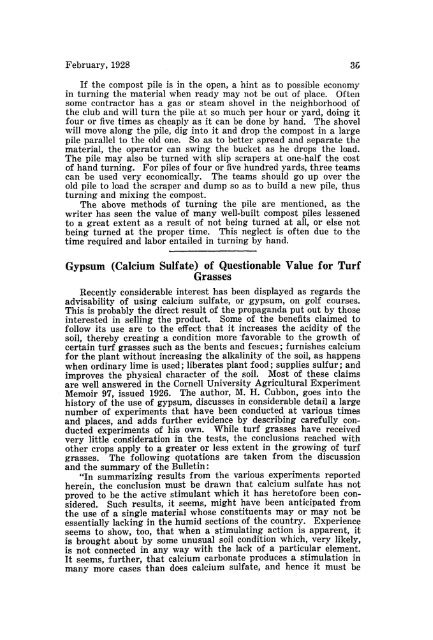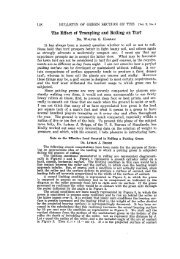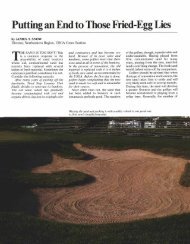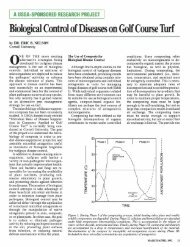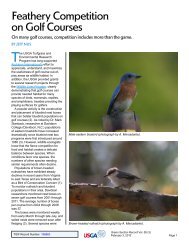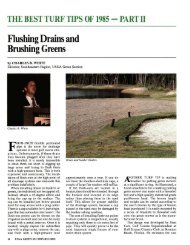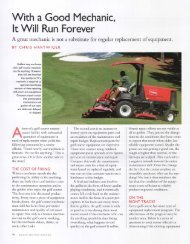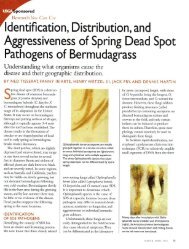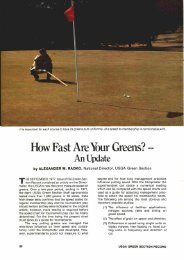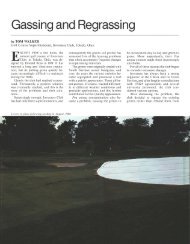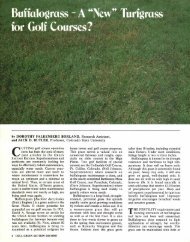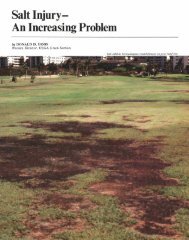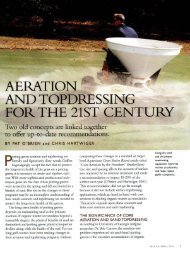Gypsum (Calcium Sulfate) of Questionable Value for Turf Grasses
Gypsum (Calcium Sulfate) of Questionable Value for Turf Grasses
Gypsum (Calcium Sulfate) of Questionable Value for Turf Grasses
You also want an ePaper? Increase the reach of your titles
YUMPU automatically turns print PDFs into web optimized ePapers that Google loves.
February, 1928 3&If the compost pile is in the open, a hint as to possible economyin turning the material when ready may not be out <strong>of</strong> place. Oftensome contractor has a gas or steam shovel in the neighborhood <strong>of</strong>the club and will turn the pile at so much per hour or yard, doing itfour or five times as cheaply as it can be done by hand. The shovelwill move along the pile, dig into it and drop the compost in a largepile parallel to the old one. So as to better spread and separate thema terial, the opera tor can swing the bucket as he drops the load.The pile may also be turned with slip scrapers at one-half the cost<strong>of</strong> hand turning. For piles <strong>of</strong> four or five hundred yards, three teamscan be used very economically. The teams should go up over theold pile to load the scraper and dump so as to build a new pile, thusturning and mixing the compost.The above methods <strong>of</strong> turning the pile are mentioned, as thewriter has seen the value <strong>of</strong> many well-built compost piles lessenedto a great extent as a result <strong>of</strong> not being turned at all, or else notbeing turned at the proper time. This neglect is <strong>of</strong>ten due to thetime required and labor entailed in turning by hand.<strong>Gypsum</strong> (<strong>Calcium</strong> <strong>Sulfate</strong>) <strong>of</strong> <strong>Questionable</strong> <strong>Value</strong> <strong>for</strong> <strong>Turf</strong><strong>Grasses</strong>Recently considerable interest has been displayed as regards theadvisability <strong>of</strong> using calcium sulfate, or ,gypsum, on golf courses.This is probably the direct result <strong>of</strong> the propaganda put out by thoseinterested in selling the product. Some <strong>of</strong> the benefits claimed t<strong>of</strong>ollow its use are to the effect that it increases the acidity <strong>of</strong> thesoil, thereby creating a condition more 'favorable to the growth <strong>of</strong>certain turf grasses such as the bents and fescues; furnishes calciunl<strong>for</strong> the plant without increasing the alkalinity <strong>of</strong> the soil, as happenswhen ordinary lime is used; liberates plant food; supplies sulfur; andimproves the physical character <strong>of</strong> the soil. Most <strong>of</strong> these claimsare well answered in the Cornell University Agricultural ExperimentMemoir 97, issued 1926. The author, M. H. Cubbon, goes into thehistory <strong>of</strong> the use <strong>of</strong> gypsum, discusses in considerable detail a largenumber <strong>of</strong> experiments that have been conducted at various timesand places, and adds further evidence by describing carefully conductedexperiments <strong>of</strong> his own. While turf grasses have receivedvery little consideration in the tests, the conclusions reached withother crops apply to a greater or less extent in the growing <strong>of</strong> turfgrasses .. The following quotations are taken from the discussionand the summary <strong>of</strong> the Bulletin:"In summarizing results from the various experiments reportedherein, the conclusion must be drawn that calcium sulfate has notproved to be the active stimulant which it has heret<strong>of</strong>ore been considered.Such results, it seems, might have been anticipated fromthe use <strong>of</strong> a single material whose constituents mayor may not beessentially lacking in the humid sections <strong>of</strong> the country. Experienceseems to show, too, that when a stimulating action is apparent, itis brought about by some unusual soil condition which, very likely,is not connected in any way with the lack <strong>of</strong> a particular element.It seems, further, that calcium carbonate produces a stimulation inmany more cases than does calcium sulfate, and hence it must be
36 February, 1928repeated here that the sulfate can not be logically recommended <strong>for</strong>as many different uses as can the carbonate."There is no good reason <strong>for</strong> thinking that gypsum produces orintensifies acid conditions in soils. The experimental evidence on thispoint is not so contradictory as one might suppose on first thought.It is true that some reports have been unfavorable to the use <strong>of</strong>gypsum, and these must be accepted as authentic even though theyare based on work not carried out in the field. However, a revie\v<strong>of</strong> the literature <strong>of</strong> the subject indicates that field experience doesnot show any detrimental acid condition due to the use <strong>of</strong> gypsum.\Vhen the soil becomes more acid under field conditions where calciumsulfate has been applied, it seems to be the result <strong>of</strong> rapid leachingtogether with an insufficie~t application <strong>of</strong> calcium to meet the leachinglosses. If the leaching losses were always considered when thequestion arises as to the amount <strong>of</strong> gypsum to be added, there shouldbe no pronounced acid condition resulting from the use <strong>of</strong> the materialalone. Usually, however, such a small quantity <strong>of</strong> calcium sulfateis added that it can have but little influence on the potentialacidity <strong>of</strong> a soil, and hence no effect in preventing the soil from becomingacid in accordance with the general tendency <strong>of</strong> soils to becomeacid. Furthermore, the use <strong>of</strong> acid phosphate, carrying as itdoes about 50 per cent <strong>of</strong> calcium sulfate, has not produced measurablesoil acidity. * * *"Data regarding the influence <strong>of</strong> calcium sulfate on bacterialactivities in soils fail to indicate a consistent and regular beneficialeffect. Other evidence' than that reported here indicates' just theopposite effect, namely, an unmistakable benefit. Since such variationsoccur, it is impossible .to recommend the general use <strong>of</strong> calciumsulfate on soils. Soils that show increased nitrate production shouldgive a response'to gypsum in the field, and no doubt they do. Theresults obtained by growing a denitrifyirig (nitrate-reducing) organismin pure culture, help to empnasize the many and varied waysin which calcium sulfate may produce a beneficial effect. * * *"The ordinary application <strong>of</strong> gypsum is not in sufficient quantityto produce a noticeable effect on the physical condition <strong>of</strong> the soil.Likewise, the moisture relations <strong>of</strong> soils do not seem to be affectedmatel'ially. Here, again, the experience from field work is not suill ..cient <strong>for</strong> conclusions to be drawn. *1 * *"Crop responses have been very uncet.tain, as has been pointedout. Experience would indicate that greater responses have beenobtained when either calcium or sulfur was a limiting factor in thesoil, than when the calcium sulfate functioned in an indirect wavto stimulate other processes. ~"Since most soils are low in sulfur, the question <strong>of</strong> supplying thatelement in some <strong>for</strong>m is rather an acute one. It remains <strong>for</strong> theindividual farmer to decide which carrier <strong>of</strong> sulfur he can use mosteffectively. * * *"<strong>Calcium</strong> sulfate had no effect on the growth <strong>of</strong> pasturegrasses. * * *"Leaching various soils with saturated calcium-sulfate solutionsdid not result in a marked liberation <strong>of</strong> potassium. * * *"<strong>Calcium</strong> sulfate had a very slight effect on the physical condition<strong>of</strong> the soil. The water-holding ability <strong>of</strong> various soils wasslightly increased, while the hydroscopic moisture capacity ,vas not
February, 1928 37affected, by heavy applications <strong>of</strong> calcium sulfate in solution <strong>for</strong>m.\Vooster silt loam soil was influenced more strongly than any other<strong>of</strong> the .soils leached."It should be remembered that many <strong>of</strong> these tests were conductedwith crops such as legumes that are frequently benefited by applications<strong>of</strong> gypsum, especially where the soil is low in sulfur. There.is little evidence that turf grasses are actually benefited by applications<strong>of</strong> gypsum, except in very limited areas. Furthermore, gypsumhas a tendency to encourage the growth <strong>of</strong> clover, which most greenkeepersand golfers regard as very objectionable. In some casesapplications <strong>of</strong> sulfur have proved actually injurious. It is furthershown by the resul.ts reported in the publication quoted aboye thatgypsum has very little effect on the soil acidity; is <strong>of</strong> little consequencein releasing plant food; and in the amounts normally used,has little effect on the physical condition <strong>of</strong> the soil. In view <strong>of</strong> thissituation any club considering the use <strong>of</strong> gypsum is strongly advisedto try it out experimentally be<strong>for</strong>e spending money, which may beworse than wasted, in purchasing large quantities <strong>of</strong> the material.Conditions Which Influence the Gro,vth <strong>of</strong> <strong>Turf</strong>By' C. A: TregillusThe study <strong>of</strong> soils and soil conditions and their effect upon turfgrowth; the study <strong>of</strong> grasses suited to varying conditions <strong>of</strong> soil andexposure; the study <strong>of</strong> fertilizers and their effect, and the study <strong>of</strong>chemicals <strong>for</strong> the control <strong>of</strong> pests and diseases, have within the lastfew years, greatly nlodified and regulated our methods <strong>of</strong> coursemaintenance. Greenkeeping is a development <strong>of</strong> the old art <strong>of</strong>gardening which, in those sections <strong>of</strong> the earth blessed with a suitableclimate, has long reached a high stage <strong>of</strong> pr<strong>of</strong>iciency and has acquiredresults <strong>of</strong> outstanding merit. It must be remembered that while agreat deal <strong>of</strong> credit is given to the climate and to the natural grassflora that lends itself to such practice, the early greenkeepershad evolved from custom and observation, a system on which reststhe basis <strong>of</strong> modern golf course management. In recent years, dueto the rapid expansion <strong>of</strong> the game <strong>of</strong> golf, the science and practice<strong>of</strong> greenkeeping has had to considerably widen its scope to embracecircumstances under which it was <strong>for</strong>merly thought impossible or atleast uneconomical to grow and maintain grass <strong>of</strong> the quality demandedby the game. Extremes <strong>of</strong> climate and other natural phenomenabring up problems that are gradually being solved both by closestudy and analysis in the laboratory, and by trial and error in theexperimental plot. This has been going on apace until there are veryfew regions left where it is not possible to produce at least a fair tomedium turf.Success in turf culture lies in thoroughly understanding thevarious influences whether natural or artificially produced, that bearupon the life hist~ry <strong>of</strong> the grass plant and being able to eliminate ormodify those that have an adverse effect and to promote those thatare conducive to healthy development. It means that we should seekto acquaint ourselves as closely as possi~le with th~ intimate relation<strong>of</strong> the common circumstances under whIch turf WIll grow.The early men possessed a vast amount <strong>of</strong> this. in<strong>for</strong>mation which,acquired by the long process <strong>of</strong> constant observatIon, and well served


